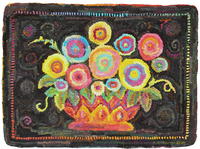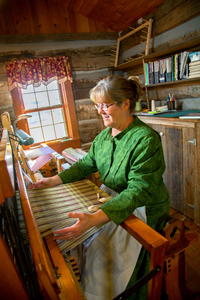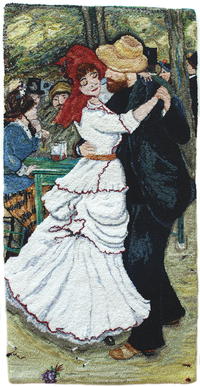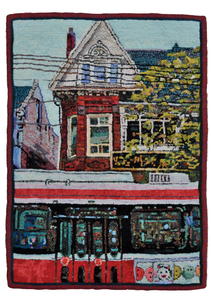Overwhelmed by Antique Black
Black, brown, purple, blue, green... just what color is that?

Carnival Paws, 15" x 11", overdyed nylon potholder loops hooked on linen. Designed and hooked by Gene Shepherd, Anaheim, California, 2012.
Whenever someone asks me about antique black, I pause a moment before answering, since coming up with the right answer is a bit overwhelming. I have heard so many completely different explanations and recipes for the process. Most probably, the term came about by attempts to describe the slightly variegated look of very dark backgrounds in old rugs. That sort of variegation can happen when every color of wool under the rainbow is thrown into a single black dye bath. While many colors of wool will go black, a few go almost black, with an odd glint of something else.
My Method of Casserole Dying
No doubt, when early rug hookers were trying to come up with enough wool to fill a background, they stretched their stash by putting whatever they had in a strong black dye bath. The end result was not only close enough for their purposes—it was interesting! Actually, it was more interesting than just plain black.
To speed up the process in modern times, master dyers from my past advised me to get an antique black look by adding either gold, chartreuse, or red to a simmering pot of off-bolt black wool. However, much like the little boy in The Emperor's New Clothes, I could never see the difference any of those three colors made on off-bolt black wool.
Over the years, I have played with the concept of antique black until I settled on my own definition: Antique black is any dye process or recipe, based on, but not limited to, black dye, that can overwhelm and unify an odd assortment of various colored and textured wool without obliterating all of the interesting highlights. Additionally, I never get an acceptable antique black by speeding up the process. I think it takes time … and a bit of fiddling. But the end result is worth the fiddling.
My process can be done in either pot or pan, with almost any combination of natural, colored, textured, new, and found wool.
Wool: The recipes in this article all require approximately 2 yards (1.5 pounds) of wool. I suggest that no piece of fabric be bigger than 1⁄8 yard. To improve dye saturation, pre-soak all wool in water at least two hours before dyeing begins. White/natural wool should be soaked in hot water with a little Synthrapol or some other wetting agent. (Because colored wools bleed easily, I suggest you pre-soak them in cold water.)
Dye: In these samples, I’ve used PRO Chem dyes. All dye colors will be mixed individually, in 4-cup vessels of boiling water before the dyeing process begins.
Read NextSlow Cooker Dyeing 101






